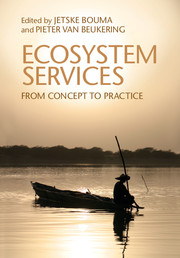1 - Ecosystem services: from concept to practice
from Part I - Introduction
Published online by Cambridge University Press: 05 February 2015
Summary
Introduction
Ecosystem services are hot, and they have been hot for a while. In 1998, Costanza et al. published their famous article about the societal value produced by ecosystems through ecosystem service delivery, an article which at the time this introduction was written had been cited more than 10 000 times. In 2005, the Millennium Ecosystem Assessment (MEA) framed the need to protect biodiversity and the world’s ecosystems in terms of ecosystem services (MEA, 2005). In 2009, “The economics of ecosystems and biodiversity” (TEEB) followed up by presenting an approach to help decision-makers recognize, demonstrate, and capture the values of ecosystem services and biodiversity. And by now, most (inter)national policies in the field of nature conservation refer to ecosystem services when explaining the need for nature conservation, biodiversity protection, and sustainable resource use.
Despite the popularity of the concept of ecosystem services, policy-makers and practitioners are struggling to implement the concept in practice. An important reason for this science–policy divide is the lack of an interdisciplinary framework that guides policy-makers through the definition and measurement of ecosystem services to their valuation and the translation of these values into effective policy instruments and governance arrangements (see also Daily et al., 2009).
- Type
- Chapter
- Information
- Ecosystem ServicesFrom Concept to Practice, pp. 3 - 22Publisher: Cambridge University PressPrint publication year: 2015
References
- 5
- Cited by



